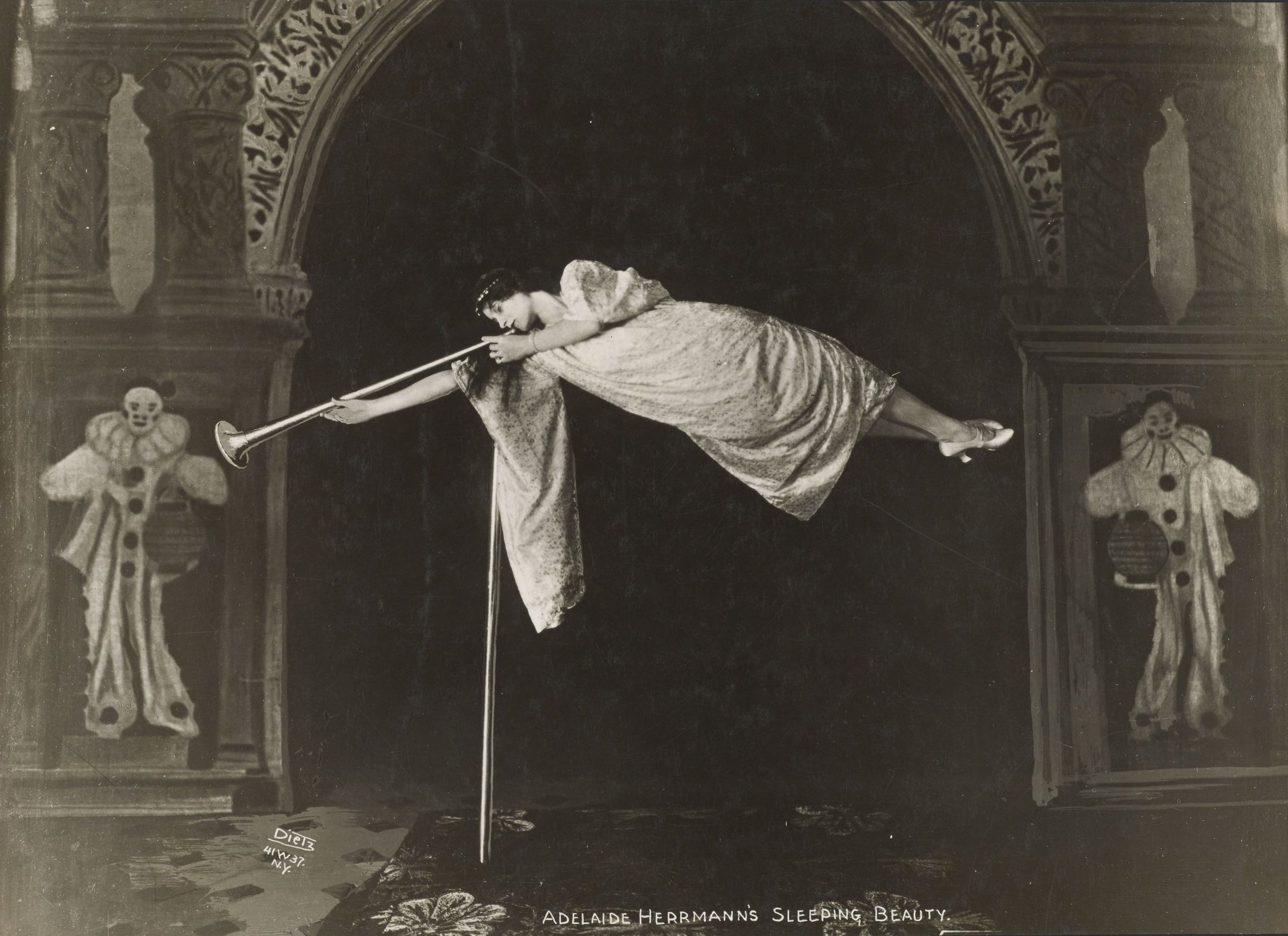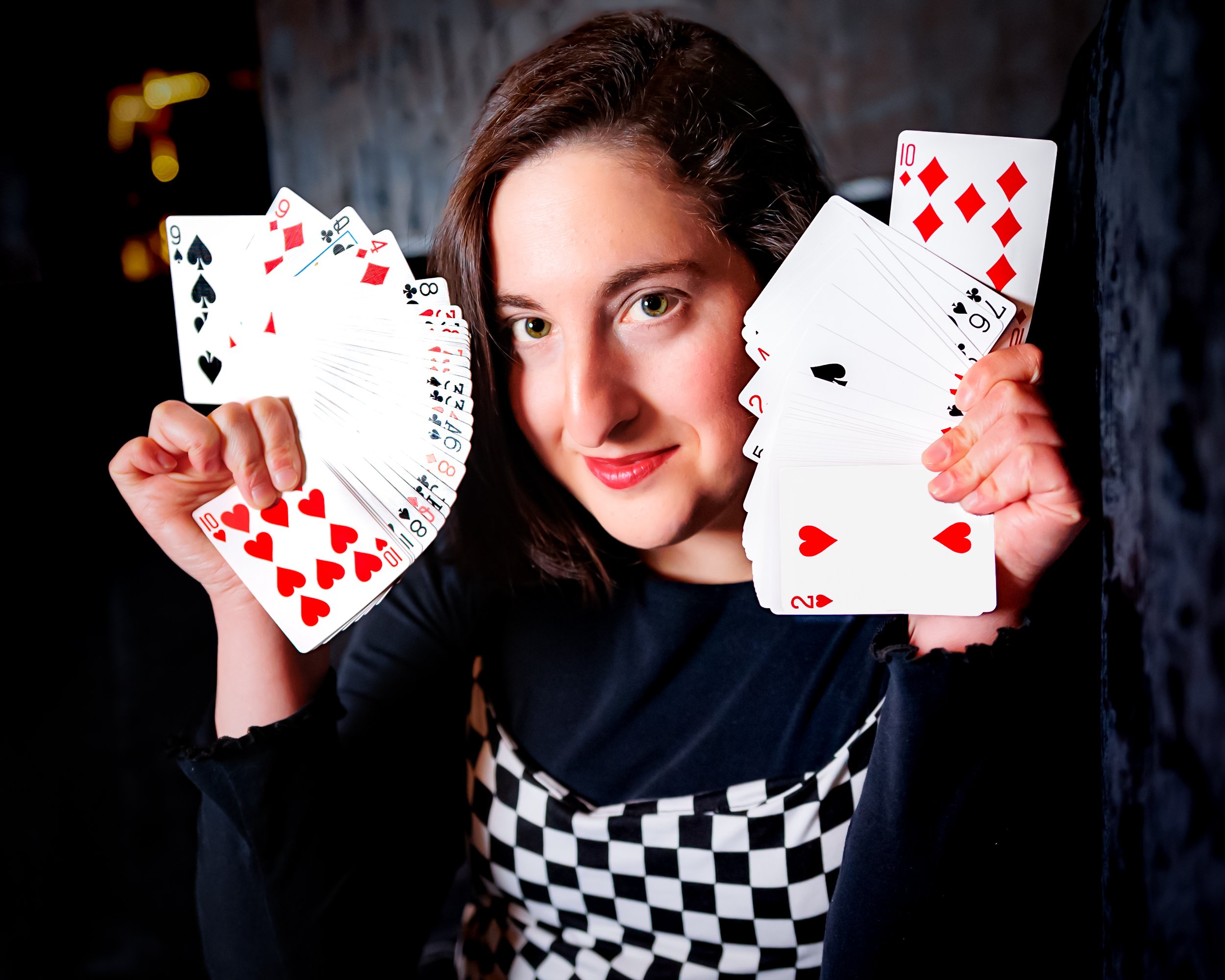
Breaking the Spell:
A Historical Perspective on Women in Magic
By William Pack | Magician, Historian, and Educator, https://libraryprogramming.com/
By Photographer unidentified - Houghton Library, Public Domain, via Wikipedia Commons
Writing in 1891, the magician Hardin Jasper Burlingame wondered at the lack of female magicians, believing there was nothing innate in women that precluded them from taking up and succeeding at the profession.
The Queen of Magic, Adelaide Herrmann, who you can read about in another essay, told a fan: "I see no reason why you should not become a good artiste of legerdemain. While there are few who have made the art a study, still we must remember that this is the new era for women . . ."
Adelaide's legacy is vital because she demonstrates that women — even in the incredibly socially restrictive environments of early 20th-century America — can be stand-alone, single-billing magicians who command their own shows and audiences.
But for a long time, the doors were barred.
Adelaide Herrmann and Company, circa 1915There were all sorts of biases. Of course, there were restrictive gender roles. Women were to stay home, cook, clean, and care for the children. Performing on stage was an improper act for a woman. For much of magic's history, being an apprentice was the only way to learn the profession. As magic books became more accessible in the 1800s, they were written specifically for boys. Later, fraternal magic organizations were men's clubs. England's Magic Circle did not start admitting women until 1991!
There would be some early departures from the "woman as assistant" trope. Queen Marie-Henriette of Belgium took lessons from Carl (Compas) Herrmann. In 1839, Madam de Lago, "the Magic Queen," performed in New Orleans. Madame Kowasky, "the celebrated Polish enchantress," appeared in Philadelphia.
Wood's Great Sensation Edna, 1900Many Victorian magicians used male assistants, usually their sons. But by the second half of the 1800s, women started to be used as assistants. They mostly played a similar role as helpmate to the male magician. He had the power and complete control over her.
Here is the hidden secret: the assistant often does the majority of the work. Without the assistant's skill, strength, flexibility, and sense of performance, the illusion would ultimately fail. In performing their famous Metamorphosis illusion, Bess Houdini had to perform all the same actions that her husband, Harry, performed, but in reverse. Yet, his fame continues alone. Never discount the importance of the magician's assistant.
By the middle of the 1800s, with early variety and vaudeville, more women were taking the stage. In the 1850s, Madame Bosco performed throughout the East and Midwest. Angie Schott originally came over from England with Professor Pepper and his famous ghost illusion, then later performed on her own. At the turn of the century, Adelaide Herrmann headlined her own act after her husband died.
Mercedes Talma (1861 – July 13, 1944) began as an assistant to her husband, Servais LeRoy, then gained equal billing in their three-person act: Le Roy, Talma, and Bosco. Talma was known as the Queen of Coins. Her skill with sleight of hand was equal to the legendary coin magician T. Nelson Downs.
"Talma, the Queen of Coins" The Irish Playgoer and Amusement Record (January 11, 1900): 9., Public Domain, via Wikipedia CommonsEllen Armstrong (1914 – 1979) was an African American female magician and daughter of Prof. John Hartford Armstrong. She got her start at the age of six as an assistant in her father's show. As a young child, she showed great skill as a "psychic" performer and even had a solo mind-reading segment in the show. When her father died suddenly in 1939, Ellen took over his show, becoming the first African American female magician touring with her own show. For 31 years, she continued to perform up and down the East Coast, mainly at Black churches and schools.
Going Fine Since 1889, Ellen E. Arstrtong. Promotional Poster via Girls Love MagicDorothy Dietrich (b. 1969) is best known for performing the bullet catch in her mouth and being the first woman to perform a straitjacket escape while being suspended hundreds of feet in the air from a burning rope. She aimed to level the playing field between men and women in the magic profession. To innovate and break barriers where no women, and in some cases no men, have gone. She was the first woman to gain prominence as an escape artist since the days of Houdini, breaking the glass ceiling for women in the field of escapes and magic. She broke barriers when she became the first magician to saw a MAN in half.
By Magicusb - Own work, Public Domain, via Wikipedia Commons Born in a small town in British Columbia, Celeste Evans (1931-2017) was initially drawn to magic partially because she was told it was something girls could not do. Dedicating herself to practice, she studied magic on her own for years. She finally convinced a local magic store owner to give her lessons. Shows around town led to an Asian tour of Canadian military bases, more touring, and eventually, her first television show. She was even part of President John F. Kennedy's Cultural Exchange Tours. These shows allowed her to entertain not only military forces but also royalty. She was the first woman to perform with doves, creating a spectacular performance. She was inducted into the SAM Hall of Fame in 1998 and awarded the AMA Performing Fellowship in Magic in 2009.
Handout photo., Evanna Evans / THE CANADIAN PRESS via CTV NewsSpace prevents me from doing them justice, but there are so many more that deserve notice:
Anna Eva Fay, Annie Abbott, Ariann Black, Becky Blaney, Dell O'Dell, Diana Zimmerman, Edna Wood, Eva Fay, Fay Presto, Frances Ireland Marshall, Frances Willard, Ionia, Jade, Jane Thurston, Jessica Jane, Juliana Chen, Julie Eng, June Merlin, Kitty Baldwin, Lisa Menna, Lulu Hurst, Luna Shimada, Marian Chavez, Minerva, Miss Undina, Misty Lee, Moi-Yo Miller, Mikayla Oz, Pam Thompson, Princess Tanaka, Princess Tenko, Romany, the Diva of Magic, Suzanne the Magician, Suzy Wandas, Tina Lenert, Vonetta.
While there have never been many female magicians, there have always been some, and that number is growing. This is a new, diverse Golden Age of Magic. These days, many female magicians are working in Las Vegas, on cruise ships, and in comedy clubs worldwide. Part of the Chicago Magic Lounge's mission is to ensure these talented women are no longer left out. The roster of permanent and repeat performers is a who's who of modern magic, such as,
Stacy Alan, Alba, Nikola Arkane, Nicole Cardoza, Ana Deguzman, Joan DuKore, Just Felice, Carisa Hendrix, Natasha Lamb, Krystyn Lambert, Gabriella Lester, Lindsey Noel, Tori Noquez, Jan Rose, Lady Sarah, Abby Segal, Paige Thompson, Simone Turkington, Rebecca Spectre, Rachel Wax, just to name a few.
Clockwise from upper left: 1. Paige Thompson, by Trainman Photography, 2. Alba, by Trainman Photography, 3. Abby Segal, by Sarah Elizabeth Larson, 4. Carisa Hendrix as Lucy Darling, by Trainman Photography, 5. Tori Noquez, by Trainman Photography.













